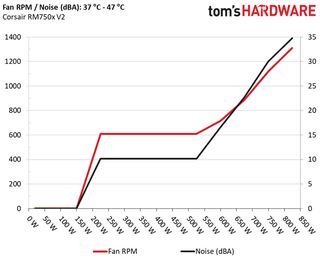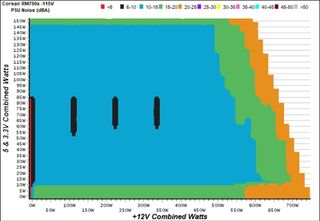Corsair RM750x PSU Review: Improving On A Classic
Why you can trust Tom's Hardware
Efficiency, Temperature & Noise
Efficiency
Our efficiency testing procedure is detailed here.
Using results from the previous page, we plotted a chart showing the RM750x’s efficiency at low loads, and loads from 10 to 110 percent of its maximum-rated capacity.




Under normal loads, the new RM750x is on par with its predecessor. Using light loads for testing, it's left behind (though not by much).
Efficiency At Low Loads
In the following tests, we measure the RM750x's efficiency at loads significantly lower than 10 percent of its maximum capacity (the lowest load the 80 PLUS standard measures). The loads we dialed were 20, 40, 60, and 80W. This is important for representing when a PC is idle, with power-saving features turned on.
| Test # | 12V | 5V | 3.3V | 5VSB | DC/AC (Watts) | Efficiency | Fan Speed | PSU Noise | PF/AC Volts |
|---|---|---|---|---|---|---|---|---|---|
| 1 | 1.197A | 0.492A | 0.482A | 0.196A | 19.659 | 66.908% | 0 RPM | <6.0 dB(A) | 0.862 |
| 12.200V | 5.034V | 3.305V | 5.029V | 29.382 | 115.08V | ||||
| 2 | 2.419A | 0.989A | 0.996A | 0.396A | 39.764 | 78.688% | 0 RPM | <6.0 dB(A) | 0.942 |
| 12.197V | 5.034V | 3.304V | 5.025V | 50.534 | 115.08V | ||||
| 3 | 3.645A | 1.484A | 1.513A | 5.020A | 59.907 | 83.865% | 0 RPM | <6.0 dB(A) | 0.967 |
| 12.195V | 5.033V | 3.302V | 5.020V | 71.433 | 115.08V | ||||
| 4 | 4.858A | 1.985A | 1.997A | 0.796A | 79.806 | 85.835% | 0 RPM | <6.0 dB(A) | 0.976 |
| 12.193V | 5.031V | 3.302V | 5.015V | 92.976 | 115.08V |
Corsair's semi-passive mode lasted through all of our tests, and the RM750x's efficiency was satisfactory under especially light loads.
5VSB Efficiency
The ATX specification, along with CEC, ErP Lot 3 2014 and ErP Lot 6 2010/2013, states that 5VSB standby supply efficiency should be as high as possible, recommending 75 percent or higher with 550mA, 1A, and 1.5A of load. The PSU should also achieve higher than 75% efficiency at 5VSB under full load, or with 3A if its max current output on this rail is higher than 3A.
We take six measurements: one each at 100, 250, 550, 1000, and 1500mA, and one with the full load the 5VSB rail can handle.
| Test # | 5VSB | DC/AC (Watts) | Efficiency | PF/AC Volts |
|---|---|---|---|---|
| 1 | 0.102A | 0.513 | 76.796% | 0.067 |
| 5.047V | 0.668 | 115.09V | ||
| 2 | 0.252A | 1.270 | 78.589% | 0.148 |
| 5.043V | 1.616 | 115.10V | ||
| 3 | 0.543A | 2.731 | 79.343% | 0.254 |
| 5.034V | 3.442 | 115.10V | ||
| 4 | 1.002A | 5.032 | 78.429% | 0.341 |
| 5.020V | 6.416 | 115.10V | ||
| 5 | 1.502A | 7.516 | 77.926% | 0.388 |
| 5.005V | 9.645 | 115.10V | ||
| 6 | 3.001A | 14.894 | 76.305% | 0.449 |
| 4.963V | 19.519 | 115.10V |


Unfortunately, this PSU's 5VSB rail wasn't as efficient as Corsair's previous-gen model. It's safe to assume that CWT made some changes to this circuit. But compared to other platforms, the new RM750x still performed pretty well.
Power Consumption In Idle And Standby
In the table below, you'll find the power consumption and voltage values of all rails (except -12V) when the PSU is idle (powered on, but without any load on its rails), and the power consumption when the PSU is in standby mode (without any load, at 5VSB).
| Mode | 12V | 5V | 3.3V | 5VSB | Watts | PF/AC Volts |
|---|---|---|---|---|---|---|
| Idle | 12.229V | 5.036V | 3.307V | 5.035V | 6.941 | 0.430 |
| 115.1V | ||||||
| Standby | 0.032 | 0.003 | ||||
| 115.1V |


Measured vampire power levels were pretty low in both test cases (115V and 230V).
Fan RPM, Delta Temperature, And Output Noise
Our mixed noise testing is described in detail here.
The first chart below illustrates the cooling fan's speed (in RPM), and the delta between input and output temperature. The results were obtained at 37°C (98.6°F) to 47°C (116.6°F) ambient temperature.

The next chart shows the cooling fan's speed (again, in RPM) and output noise. We measured acoustics from one meter away, inside a hemi-anechoic chamber. Background noise inside the chamber was below 6 dB(A) during testing (it's actually much lower, but our sound meter’s microphone hits its floor), and the results were obtained with the PSU operating at 37°C (98.6°F) to 47°C (116.6°F) ambient temperature.

The following graph illustrates the fan's output noise over the PSU's operating range. The same conditions of the above graph apply to our measurements, though the ambient temperature was between 30°C (86°F) to 32°C (89.6°F).

Once you stress the minor rails of these CWT platforms, they no longer operate passively. Fortunately, their fans spin slowly and don't make much noise. You have to apply more than 570W load on the +12V rail in order to make the RM750x output more than 20 dB(A) in a 32°C ambient environment.
MORE: Best Power Supplies
MORE: How We Test Power Supplies
MORE: All Power Supply Content
Current page: Efficiency, Temperature & Noise
Prev Page Load Regulation, Hold-Up Time & Inrush Current Next Page Protection FeaturesStay On the Cutting Edge: Get the Tom's Hardware Newsletter
Get Tom's Hardware's best news and in-depth reviews, straight to your inbox.
Aris Mpitziopoulos is a Contributing Editor at Tom's Hardware US, covering PSUs.
-
joedavies87 I bought one last year and did not realize that I would need two EPS cables for future builds. Moved to EVGA. Corsair was too late.Reply